Omron BP785N Owner's Manual
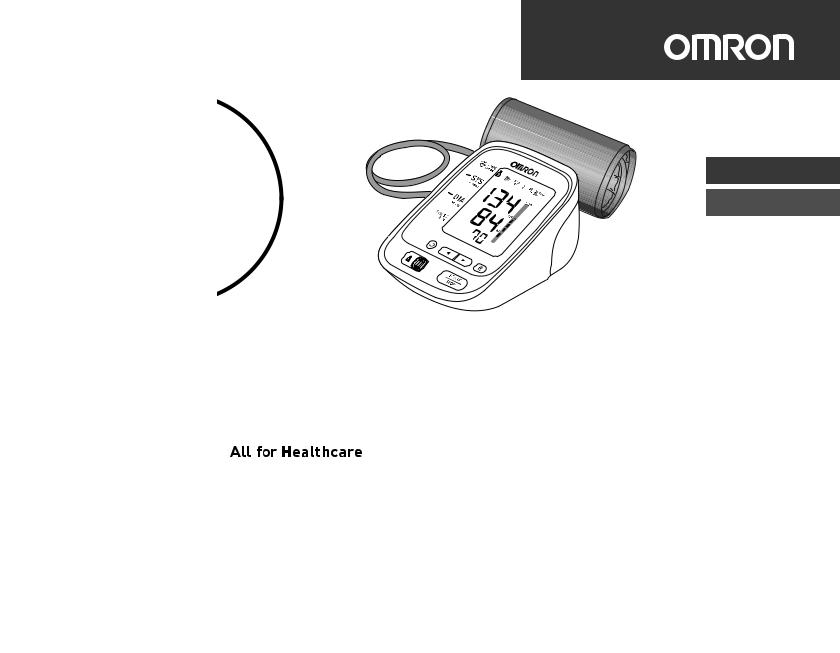
English
Español
10 series Blood Pressure Monitor
Model BP785N
Instruction Manual
2298861-6C i
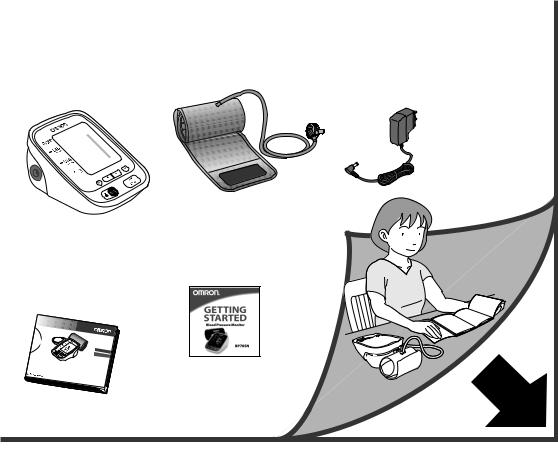
Product includes:
El producto incluye:
AC Adapter
Adaptador de CA
ComFit™ Cuff
Brazalete
Monitor
Monitor
Englis
Español
10 |
series Blood |
|
|
|
Model |
Pressure |
Monitor |
|
BP785N |
||
|
Instruction |
|
|
|
|
Manual |
|
Instruction Manual
Manual de Instrucciones
ii
Quick Start Guide Guía resumida

Contents
Thank you for purchasing the OMRON® BP785N Blood Pressure Monitor.
Your new blood pressure monitor uses the oscillometric method of blood pressure measurement. This means the monitor detects your blood movement through your brachial artery and converts the movements into a digital reading. An oscillometric monitor does not need a stethoscope so the monitor is simple to use.
Intended Use
This device is a digital monitor intended for use in measuring blood pressure and pulse rate in adult patient population who can understand this instruction manual with the arm circumference range printed on the arm cuff. The device detects the appearance of irregular heartbeats during measurement and gives a warning signal with the measurement result.
Important Safety Information ........................ |
1 |
|
3.4 |
Using the Memory Function................. |
18 |
||
1. |
Know Your Device.................................... |
4 |
4. |
Error Messages and Troubleshooting..21 |
|||
|
1.1 |
Display Symbols..................................... |
5 |
|
4.1 |
Error Messages ................................... |
21 |
|
1.2 |
Before Taking a Measurement............... |
6 |
|
4.2 |
Troubleshooting................................... |
23 |
2. |
Preparation ............................................... |
7 |
5. |
Maintenance and Storage ...................... |
24 |
||
|
2.1 |
Battery Installation.................................. |
7 |
|
5.1 |
Maintenance ........................................ |
24 |
|
2.2 |
Using the AC adapter............................. |
8 |
|
5.2 |
Storage ................................................ |
25 |
|
2.3 |
Setting the TruReadTM Mode.............. |
10 |
|
5.3 |
Optional Medical Accessories ............. |
26 |
|
2.4 |
Setting the Date and Time ................... |
11 |
6. |
Specifications ......................................... |
27 |
|
3. |
Using the Device .................................... |
12 |
7. |
FCC Statement........................................ |
28 |
||
|
3.1 |
Applying the Arm Cuff .......................... |
12 |
8. |
Limited Warranty .................................... |
29 |
|
|
3.2 |
How to Sit Correctly ............................. |
13 |
9. |
Guidance and Manufacturer’s Declaration.. 30 |
||
|
3.3 |
Taking a Measurement ........................ |
14 |
|
|
|
|
Please read this instruction manual thoroughly before using the device. Please keep for future reference. For specific information about your own blood pressure, CONSULT YOUR PHYSICIAN.

Important Safety Information
 Warning: Indicates a potentially hazardous situation which, if not avoided, could result in death or serious injury.
Warning: Indicates a potentially hazardous situation which, if not avoided, could result in death or serious injury.
(General Usage)
 DO NOT adjust medication based on measurement results from this blood pressure monitor. Take medication as prescribed by your physician. Only a physician is qualified to diagnose and treat High Blood Pressure.
DO NOT adjust medication based on measurement results from this blood pressure monitor. Take medication as prescribed by your physician. Only a physician is qualified to diagnose and treat High Blood Pressure.
 The monitor is not intended to be a diagnostic device.
The monitor is not intended to be a diagnostic device.
 Consult your physician before using the device for any of the following conditions: common arrhythmias such as atrial or ventricular premature beats or atrial fibrillation, arterial sclerosis, poor perfusion, diabetes, age, pregnancy, pre-eclampsia, renal diseases.
Consult your physician before using the device for any of the following conditions: common arrhythmias such as atrial or ventricular premature beats or atrial fibrillation, arterial sclerosis, poor perfusion, diabetes, age, pregnancy, pre-eclampsia, renal diseases.
Note that PATIENT motion, trembling, shivering may affect the measurement reading.  Do not use the device on the injured arm or the arm under medical treatment.
Do not use the device on the injured arm or the arm under medical treatment.
 Do not apply the arm cuff on the arm while being on an intravenous drip or blood transfusion.
Do not apply the arm cuff on the arm while being on an intravenous drip or blood transfusion.
 Consult your physician before using the device on the arm with an arterio-venous (A-V) shunt.
Consult your physician before using the device on the arm with an arterio-venous (A-V) shunt.
 Do not use the device with other medical electrical (ME) equipment simultaneously.
Do not use the device with other medical electrical (ME) equipment simultaneously.
 Do not use the device in the area the HF surgical equipment, MRI, or CT scanner exists, or in the oxygen rich environment.
Do not use the device in the area the HF surgical equipment, MRI, or CT scanner exists, or in the oxygen rich environment.
 The air tube or the AC adapter cable may cause accidental strangulation in infants.
The air tube or the AC adapter cable may cause accidental strangulation in infants.
 Contains small parts that may cause a choking hazard if swallowed by infants.
Contains small parts that may cause a choking hazard if swallowed by infants.
(AC Adapter Usage)
 Do not use the AC adapter if the device or the power cord is damaged. Turn off the power and unplug the power cord immediately.
Do not use the AC adapter if the device or the power cord is damaged. Turn off the power and unplug the power cord immediately.
 Plug the AC adapter into the appropriate voltage outlet. Do not use in a multi-outlet plug.
Plug the AC adapter into the appropriate voltage outlet. Do not use in a multi-outlet plug.  Never plug in or unplug the power cord from the electric outlet with wet hands.
Never plug in or unplug the power cord from the electric outlet with wet hands.
EN |
1

Important Safety Information
 Caution: Indicates a potentially hazardous situation which, if not avoided, may result in minor or moderate injury to the user or patient or damage to the equipment or other property.
Caution: Indicates a potentially hazardous situation which, if not avoided, may result in minor or moderate injury to the user or patient or damage to the equipment or other property.
(General Usage)
 Always consult your physician. Self-diagnosis of measurement results and self-treatment are dangerous.
Always consult your physician. Self-diagnosis of measurement results and self-treatment are dangerous.
 Consult your physician before using the device for any of the following conditions: •If you have had a mastectomy.
Consult your physician before using the device for any of the following conditions: •If you have had a mastectomy.
•Do not take measurements more than necessary. It may cause bruising due to blood flow interference. •People with severe blood flow problems or blood disorders as cuff inflation can cause bruising.
 Remove the arm cuff if it does not start deflating during the measurement.
Remove the arm cuff if it does not start deflating during the measurement.
 Do not use this device on infants or persons who cannot express their intentions.
Do not use this device on infants or persons who cannot express their intentions.
 Do not use the device for any purpose other than measuring blood pressure.
Do not use the device for any purpose other than measuring blood pressure.
 Use only the approved arm cuff for this device. Use of other arm cuffs may result in incorrect measurement results.
Use only the approved arm cuff for this device. Use of other arm cuffs may result in incorrect measurement results.
 Do not use a mobile phone or other devices that emit electromagnetic fields, near the device. This may result in incorrect operation of the device.
Do not use a mobile phone or other devices that emit electromagnetic fields, near the device. This may result in incorrect operation of the device.
 Do not disassemble the monitor or arm cuff. This may cause an inaccurate reading.
Do not disassemble the monitor or arm cuff. This may cause an inaccurate reading.
 Do not use in a location with moisture, or a location where water may splash on the device. This may damage the device.
Do not use in a location with moisture, or a location where water may splash on the device. This may damage the device.
 Do not use the device in a moving vehicle (car, airplane).
Do not use the device in a moving vehicle (car, airplane).
 Read "If your systolic pressure is more than 210 mmHg" (page14) of this instruction manual, if your systolic pressure is known to be more than 210 mmHg. Inflating to a higher pressure than necessary may result in bruising where the cuff is applied.
Read "If your systolic pressure is more than 210 mmHg" (page14) of this instruction manual, if your systolic pressure is known to be more than 210 mmHg. Inflating to a higher pressure than necessary may result in bruising where the cuff is applied.
(AC Adapter Usage)
 Fully insert the power plug into the outlet.
Fully insert the power plug into the outlet.
 When disconnecting the power plug from the outlet, do not pull the power cord. Be sure to pull from the power plug safely.
When disconnecting the power plug from the outlet, do not pull the power cord. Be sure to pull from the power plug safely.
2

Important Safety Information
 When handling the power cord, take care not to do the following:
When handling the power cord, take care not to do the following:
Do not damage. |
Do not break it. |
Do not tamper with it. |
Do not forcibly bend or pull. |
Do not twist. |
Do not bundle during use. |
Do not pinch. |
Do not place under heavy objects. |
Wipe the dust off from the power plug. |
|
Unplug monitor when not in use. |
|
 Disconnect the power plug before cleaning.
Disconnect the power plug before cleaning.
 Use only an OMRON AC adapter designed for this device. Use of unsupported adapters may damage and/or may be hazardous to the device.
Use only an OMRON AC adapter designed for this device. Use of unsupported adapters may damage and/or may be hazardous to the device.
EN |
(Battery Usage)
 Do not insert the batteries with their polarities incorrectly aligned.
Do not insert the batteries with their polarities incorrectly aligned.
 Use only 4 “AA” alkaline or manganese batteries with this device. Do not use other types of batteries. Do not use new and used batteries together.
Use only 4 “AA” alkaline or manganese batteries with this device. Do not use other types of batteries. Do not use new and used batteries together.
 Remove the batteries if the device will not be used for three months or more.
Remove the batteries if the device will not be used for three months or more.
General Precautions
•Do not forcibly crease the arm cuff or the air tube excessively.
•Do not press the air tube while taking a measurement.
•To unplug the air plug, pull on the air plug at the connection with the monitor, not the tube itself.
•Do not drop the monitor or subject device to strong shocks or vibrations.
•Do not inflate the arm cuff when it is not wrapped around your arm.
•Do not use the device outside the specified environment. It may cause an inaccurate reading.
•Dispose of the device, components and optional accessories according to applicable local regulations. Unlawful disposal may cause environmental pollution.
3

1. Know Your Device

 Open the rear cover page to read the following:
Open the rear cover page to read the following:
The letter identifiers on the rear cover page correspond to those in the body of this page.
Monitor
AAir jack
BBlood pressure color indicator
CDate/Time setting button
DUSER ID selection switch
EDisplay
FMemory button
GSTART/STOP button
HUp/Down buttons
I Battery compartment
J AC adapter jack
Arm cuff
K Arm cuff (Arm circumference 9” - 17” (22 - 42 cm))
L Air plug
M Air tube
4
Display
NMemory symbol
OUSER ID symbol
PAverage value symbol
QSystolic blood pressure
RDiastolic blood pressure
SHeartbeat symbol
(Flashes during measurement)
TDate/Time display
UTruReadTM symbol
VMovement error symbol W Irregular heartbeat symbol
XBlood pressure level indicator
YLow battery symbol
ZDeflation symbol
AA Pulse display / Memory number
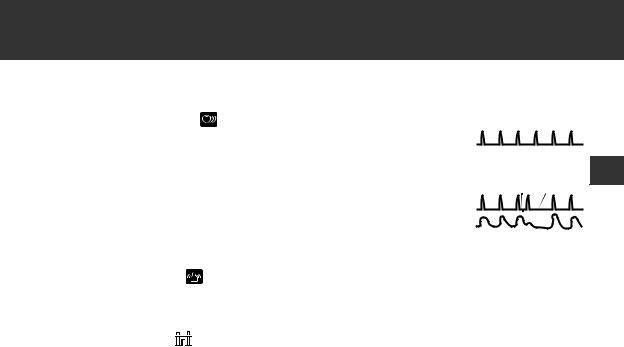
1. Know Your Device
1.1 Display Symbols
Irregular Heartbeat Symbol ( )
When the monitor detects an irregular rhythm two or more times during the measurement, the irregular heartbeat symbol will appear on the display with the measurement values.
An irregular heartbeat rhythm is defined as a rhythm that is 25% less or 25% more than the average rhythm detected while the monitor is measuring the systolic and diastolic blood pressure.
If the irregular heartbeat symbol displays with your measurement results, we recommend you consult your physician. Follow the directions
of your physician.
Normal Heartbeat
Pulse
Blood pressure
Irregular Heartbeat
Short Long
Pulse
Blood pressure
Movement Error Symbol ( )
The movement error symbol is displayed if you move your body during the measurement. Please remove the arm cuff, and wait 2-3 minutes. Take another measurement, remain still during measurement.
Average Value Symbol ( )
The average value symbol is displayed when you press and hold the memory button for more than 3 seconds. The most recent average value appears on the display screen.
EN |
5

1. Know Your Device
Blood Pressure Color Indicator
If your Systolic Blood Pressure is 135 mmHg or above and/or the Diastolic Blood Pressure is 85 mmHg or above, the blood pressure color indicator will light in “orange” when the measurement result is displayed. If the results are within the standard range, the blood pressure color indicator will light in “green”.
2013 ESH/ESC Guidelines for the management of arterial hypertension
Definitions of hypertension by office and home blood pressure levels
|
Office |
Home |
|
|
|
Systolic Blood Pressure |
≥ 140 mmHg |
≥ 135 mmHg |
|
|
|
Diastolic Blood Pressure |
≥ 90 mmHg |
≥ 85 mmHg |
|
|
|
These are from statistical values for blood pressure.
1.2 Before Taking a Measurement
To help ensure an accurate reading, follow these directions:
1.Avoid bathing, drinking alcohol or caffeine, smoking, exercising and eating for 30 minutes before taking a measurement. Rest for at least 15 minutes before taking the measurement.
2.Stress raises blood pressure. Avoid taking measurements during stressful times.
3.Measurements should be taken in a quiet place.
4.Remove tight-fitting clothing from your arm.
5.Sit on a chair with your feet flat on the floor. Rest your arm on a table so that the arm cuff is at the same level as your heart.
6.Remain still and do not talk during the measurement.
7.Keep a record of your blood pressure and pulse readings for your physician. A single measurement does not provide an accurate indication of your true blood pressure. You need to take and record several readings over a period of time. Try to measure your blood pressure at the same time each day for consistency.
6
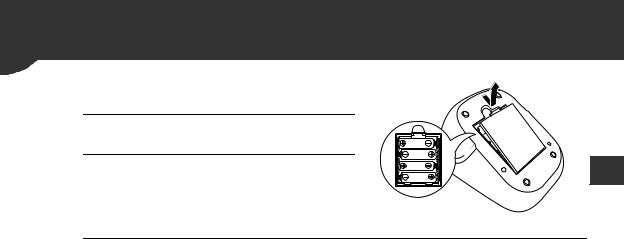
2. Preparation
2.1 |
Battery Installation |
|
1. |
Remove the battery cover. |
|
2. |
Insert 4 “AA” batteries as |
EN |
|
indicated in the battery |
|
|
compartment. |
|
3. |
Replace the battery cover. |
|
Notes:
•When the low battery symbol (  ) appears on the display, turn the monitor off, then replace all batteries at the same time. Long life alkaline batteries are recommended.
) appears on the display, turn the monitor off, then replace all batteries at the same time. Long life alkaline batteries are recommended.
•The measurement values continue to be stored in memory even after the batteries are replaced.
•Dispose of the device, components and optional accessories according to applicable local regulations. Unlawful disposal may cause environmental pollution.
7

2. Preparation
2.2 Using the AC adapter
IMPORTANT SAFETY INSTRUCTIONS
SAVE THESE INSTRUCTIONS
- DANGER -
TO REDUCE THE RISK OF FIRE OR ELECTRIC SHOCK, CAREFULLY FOLLOW THESE INSTRUCTIONS.
 The power unit (AC Adapter) is intended to be correctly oriented in a vertical or floor mount position.
The power unit (AC Adapter) is intended to be correctly oriented in a vertical or floor mount position.
NOTES:
•Use only the authorized OMRON AC Adapter that came with this monitor.
•We recommend you install the batteries even if the AC Adapter is used. If no batteries are installed, you may need to reset the date and time if the AC Adapter is disconnected. The measurement results will not be deleted.
 Use only OMRON authorized parts and accessories. Parts and accessories not approved for use with the device may damage the device.
Use only OMRON authorized parts and accessories. Parts and accessories not approved for use with the device may damage the device.
8
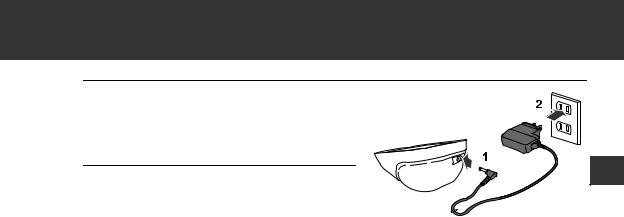
2. Preparation
1. Insert the AC adapter plug into the AC adapter jack on the rear side of the monitor.
2. Plug the AC adapter into an |
EN |
electrical outlet. |
|
To disconnect the AC adapter, unplug the AC adapter from the electrical outlet first and then remove the AC adapter plug from the monitor.
9
